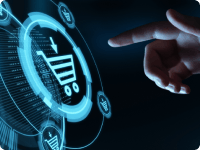Customer Journey
A customer journey is a process of visually mapping the exact process a customer or a prospect goes through with intent to perform the desired action with a company. Such journeys help companies understand their customers’ motivations to purchase and pain points so that they can directly attribute the products and services to address those pain points.
The stages a customer travels through in their relationship with the brand right from awareness to consideration, intent and purchase, each consumer decision journey differs per person and encompasses a variety of potential touchpoints and experiences a customer can share with a brand. Different journeys represent very different stages in the life cycle. Some, initiated at the awareness phase, require more touchpoints to purchase while the others, already exhibiting intent, move faster through the lifecycle on their path to conversion.
Mapping customer journeys:
As an organisation, it is key to analyze the user behavior of your customers i.e., to understand how your customers travel through the entire sales process and how they feel during their time there. Using a customer journey map is the most sought after approach for achieving this. To be more precise, this approach
- allows organizations and all decision-makers to stay focused on their customers
- helps transform every step of the purchase process easier for potential leads
As customer acquisition costs continue to rise, it’s become common for brands to practice customer experience management while delivering on desired outcomes faster.
Customer Journey Mapping – Best Practices
- Define the objectives for the maps
Before diving deep into the map, it is best to pen down answers to a few basic questions about the map like – What is the primary goal of this map? Who is this map intended for? Who is this map not intended for? Answering these questions will automatically have you creating buyer personas. A buyer persona is a semi-fictional representation of a company’s ideal customer based on market research and real data about their existing customers.
2. Segment the personas and define their individual goals
Gather feedback from existing customers through questionnaires or surveys. After receiving feedback from an appreciable number of responses, you will start observing patterns in the responses received which will eventually help you segment the personas based on the feedback.
Once you have segmented the personas, start defining the goals for each of the personas. Again, looking back at the feedback responses will be a good starting point to this. Keep in mind that no two sets of personas can have the same goal. If they do, make sure they are regrouped into a single persona.
3. List down all the touchpoints
Listing down the touchpoints and getting the true sense of every single touchpoint is an effective way of understanding the ease and objectives of customer journeys. Making a list also helps in distributing content or marketing efforts equally across every touchpoint. This way, a company can make sure that every customer journey is equally engaging and as a result, can see lesser drop-offs midway through the journey.
4. Determine your most and least effective channels
This step is of key importance to companies that are just starting out and to companies that are expanding their marketing efforts through newer channels. Map each channel with its ideal customer persona that you have already created. This way, you can make sure you invest your marketing efforts only into the channels where your personas are matched to. Channels that cannot be mapped with any of your segmented personas can simply be put aside until newer personals are built out that match these channels. One has to remember that the personas should be segmented first after which they have to be mapped to the channels and that this cannot happen the other way around.
5. Be the customer yourself
Step into the shoes of your customers and take the customer journey yourself. This will not only help you analyze the efficiency of the journey you have created but doing it early will give you the option to make necessary changes to it before putting it out there.
Read this Blog and find out out how Vue.ai helps improve customer experience



